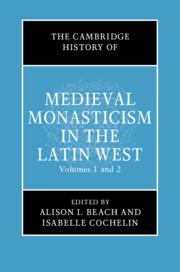Book contents
- The Cambridge History of Medieval Monasticism in the Latin WEST
- The New Cambridge History of Medieval Monasticism in the Latin West
- The Cambridge History of Medieval Monasticism in the Latin WEST
- Copyright page
- Contents
- Figures
- Contributors
- Acknowledgments
- Abbreviations
- 1 General Introduction
- Part I The Origins of Christian Monasticism to the Eighth Century
- 2 The Monastic Laboratory: Perspectives of Research in Late Antique and Early Medieval Monasticism
- 3 Re-Reading Monastic Traditions: Monks and Nuns, East and West, from the Origins to c. 750
- 4 The Archaeology of the Earliest Monasteries
- 5 Egyptian Nuns in Late Antiquity as Exemplars
- 6 Psalmody and Prayer in Early Monasticism
- 7 Heterodoxy and Monasticism around the Mediterranean Sea
- 8 The Invention of Western Monastic Literature: Texts and Communities
- 9 Monastic Rules (Fourth to Ninth Century)
- 10 Social Plurality and Monastic Diversity in Late Antique Hispania (Sixth to Eighth Century)
- 11 Female House Ascetics from the Fourth to the Twelfth Century
- 12 The Archaeology of the Earliest Monasteries in Italy and France (Second Half of the Fourth Century to the Eighth Century)
- 13 Nuns and Monks at Work: Equality or Distinction between the Sexes? A Study of Frankish Monasteries from the Sixth to the Tenth Century
- 14 Ascetic Prayer for the Dead in the Early Medieval West
- 15 Monastic Identity in Early Medieval Ireland
- 16 Constructing Monastic Space in the Early and Central Medieval West (Fifth to Twelfth Century)
- 17 The Economy of Byzantine Monasteries
- Part II The Carolingians to the Eleventh Century
- Part III The Long Twelfth Century
- Part IV Forms of Monasticism in the Late Middle Ages
- Index
- References
16 - Constructing Monastic Space in the Early and Central Medieval West (Fifth to Twelfth Century)
from Part I - The Origins of Christian Monasticism to the Eighth Century
Published online by Cambridge University Press: 16 January 2020
- The Cambridge History of Medieval Monasticism in the Latin WEST
- The New Cambridge History of Medieval Monasticism in the Latin West
- The Cambridge History of Medieval Monasticism in the Latin WEST
- Copyright page
- Contents
- Figures
- Contributors
- Acknowledgments
- Abbreviations
- 1 General Introduction
- Part I The Origins of Christian Monasticism to the Eighth Century
- 2 The Monastic Laboratory: Perspectives of Research in Late Antique and Early Medieval Monasticism
- 3 Re-Reading Monastic Traditions: Monks and Nuns, East and West, from the Origins to c. 750
- 4 The Archaeology of the Earliest Monasteries
- 5 Egyptian Nuns in Late Antiquity as Exemplars
- 6 Psalmody and Prayer in Early Monasticism
- 7 Heterodoxy and Monasticism around the Mediterranean Sea
- 8 The Invention of Western Monastic Literature: Texts and Communities
- 9 Monastic Rules (Fourth to Ninth Century)
- 10 Social Plurality and Monastic Diversity in Late Antique Hispania (Sixth to Eighth Century)
- 11 Female House Ascetics from the Fourth to the Twelfth Century
- 12 The Archaeology of the Earliest Monasteries in Italy and France (Second Half of the Fourth Century to the Eighth Century)
- 13 Nuns and Monks at Work: Equality or Distinction between the Sexes? A Study of Frankish Monasteries from the Sixth to the Tenth Century
- 14 Ascetic Prayer for the Dead in the Early Medieval West
- 15 Monastic Identity in Early Medieval Ireland
- 16 Constructing Monastic Space in the Early and Central Medieval West (Fifth to Twelfth Century)
- 17 The Economy of Byzantine Monasteries
- Part II The Carolingians to the Eleventh Century
- Part III The Long Twelfth Century
- Part IV Forms of Monasticism in the Late Middle Ages
- Index
- References
Summary
The practice of asceticism may represent a rupture with the world, but in the early medieval West it notably encouraged the establishment of “small worlds,” to use the expression of Wendy Davies to describe the numerous, largely cloistered groups that came to replace the social and political institutions of the ancient world. The structure of these small monastic worlds was defined, in the first place, by a way of life regulated according to written norms and by the establishment of well-defined, hierarchically organized complexes of space. Several contributions to this volume demonstrate that this twofold process, characteristic of the history of Western monasticism, emerged only gradually. It took centuries for religious experience to become equated with a disciplined way of life, let alone a single monastic rule, and for the conception and establishment of a topography specific to the requirements of monastic living to develop.
- Type
- Chapter
- Information
- The Cambridge History of Medieval Monasticism in the Latin West , pp. 317 - 339Publisher: Cambridge University PressPrint publication year: 2020
References
- 2
- Cited by

